Content
All issues / Volume 17 (2023) / Issue 8 (August)
Robert T. Woodward, Alexander Bismarck
Vol. 17., No.8., Pages 771-772, 2023
DOI: 10.3144/expresspolymlett.2023.57
Vol. 17., No.8., Pages 771-772, 2023
DOI: 10.3144/expresspolymlett.2023.57
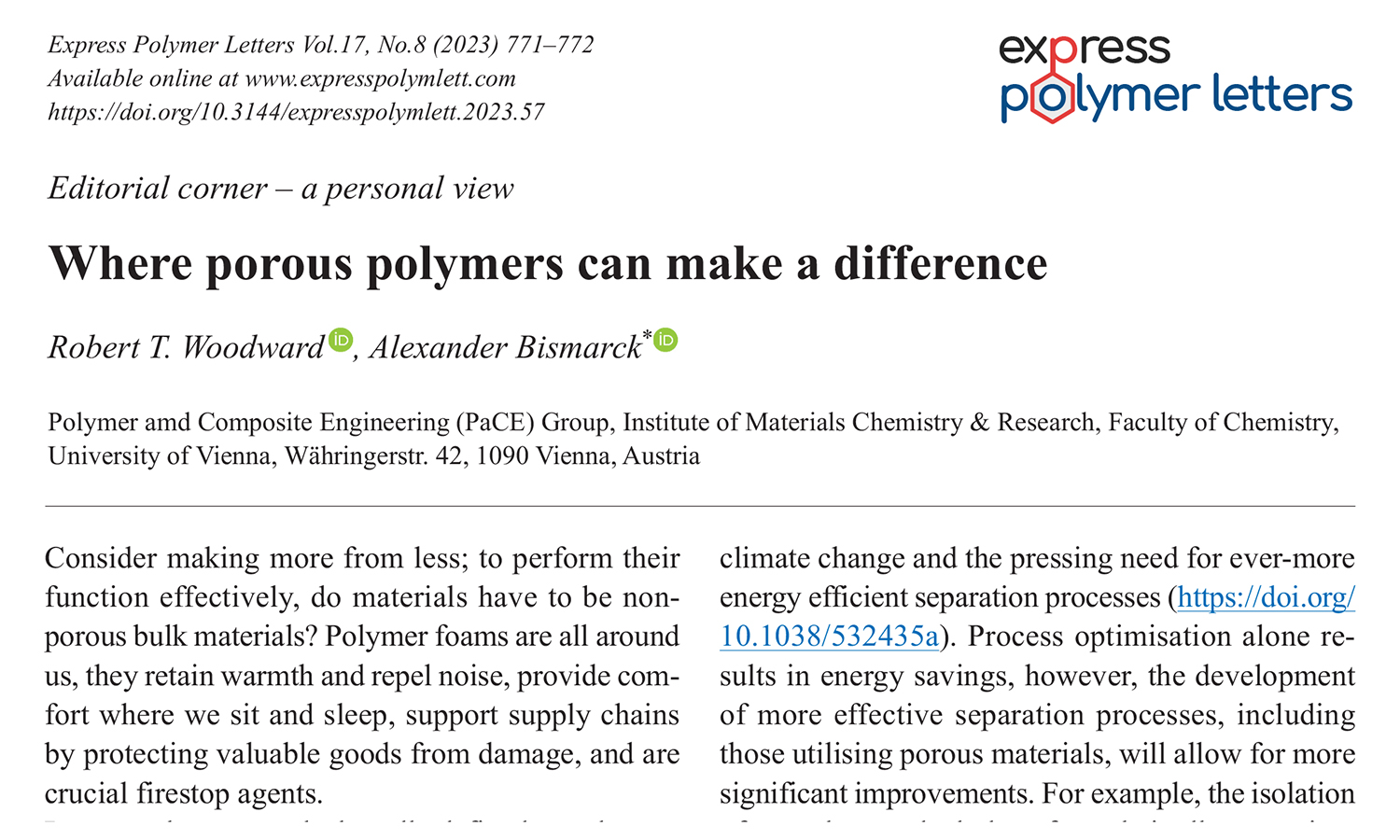
This is an editorial article. It has no abstract.
Juan Ivorra-Martinez, Yago Valencia, Jaume Gomez-Caturla, Angel Agüero, Marina Patricia Arrieta, Teodomiro Boronat, Rafael Balart
Vol. 17., No.8., Pages 773-788, 2023
DOI: 10.3144/expresspolymlett.2023.58
Vol. 17., No.8., Pages 773-788, 2023
DOI: 10.3144/expresspolymlett.2023.58
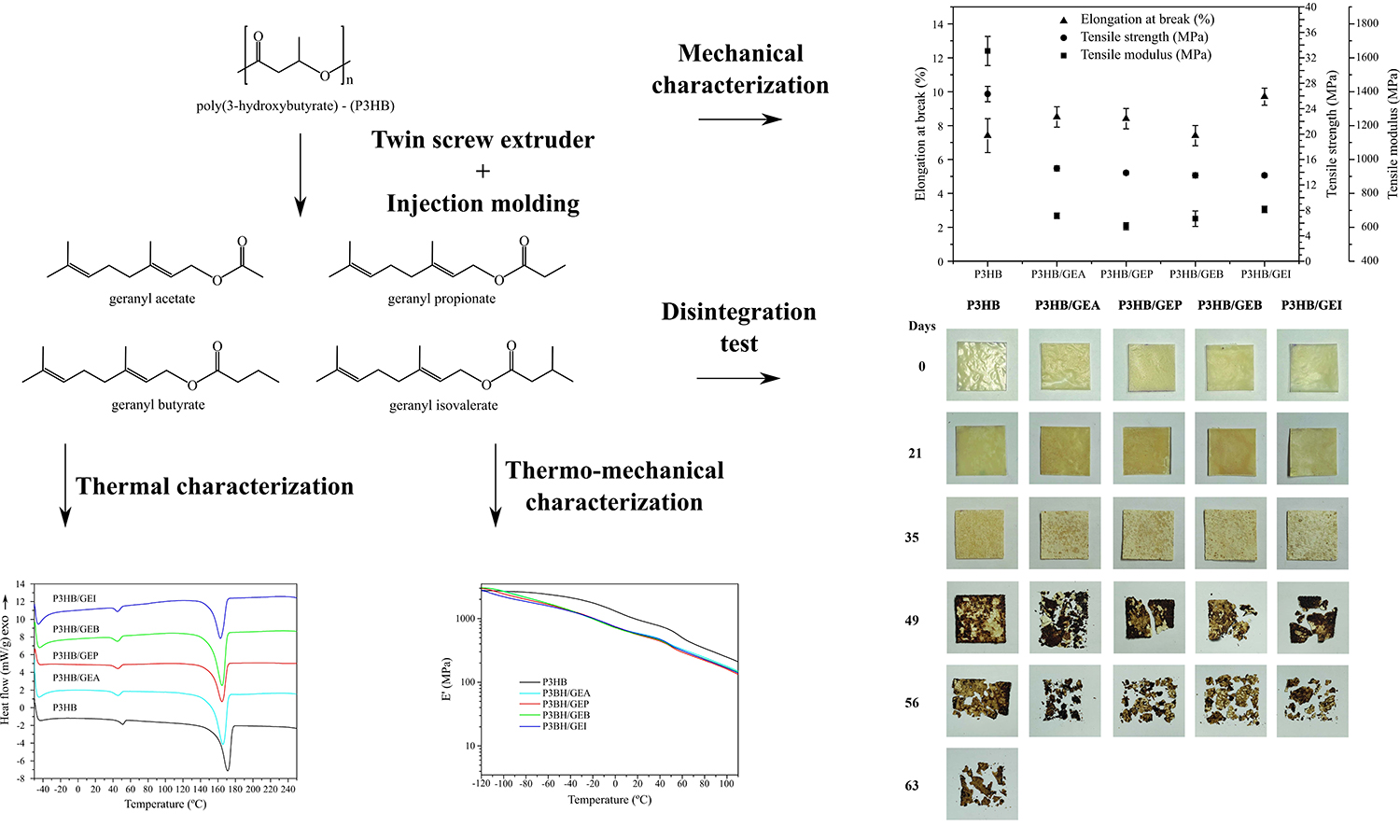
Poly(3-hydroxybutyrate) (P3HB) is, by far, one of the most promising bacterial polyesters at the commercial scale, but it is a brittle polymer due to physical aging occurring at room temperature, which promotes secondary crystallization. Plasticization is a cost-effective and technical approach to overcome or minimize, this drawback. In this work, the use of terpenoid-based organic compounds as plasticizers for P3HB is proposed. Geranyl esters with different chain length carboxylic acids, namely acetic (C2), propionic (C3), butyric (C4), and isovaleric (C5) acids, are used at a constant proportion with the main aim of improving the ductility of P3HB. In addition, thermal properties, morphology, and disintegration are also addressed. All geraniol-based plasticizers provided increased ductility. The elongation at break of neat P3HB (7.4%) increased up to 9.7%, which represents a percentage increase of 31.1%. A remarkable increase in toughness is also obtained by a change in the impact strength from 2.2 kJ·m–2 (neat P3HB) up to 3.4 kJ·m–2 with geranyl acetate. Thus, the proposed P3HB formulations widen the potential uses of P3HB since its ductile properties are improved. Other relevant results are related to the glass transition temperature reduction and an increase in the disintegration rate in controlled compost soil.
Jaume Gomez-Caturla, Nestor Montanes, Luis Quiles-Carrillo, Rafael Balart, Daniel Garcia-Garcia, Franco Dominici, Debora Puglia, Luigi Torre
Vol. 17., No.8., Pages 789-805, 2023
DOI: 10.3144/expresspolymlett.2023.59
Vol. 17., No.8., Pages 789-805, 2023
DOI: 10.3144/expresspolymlett.2023.59
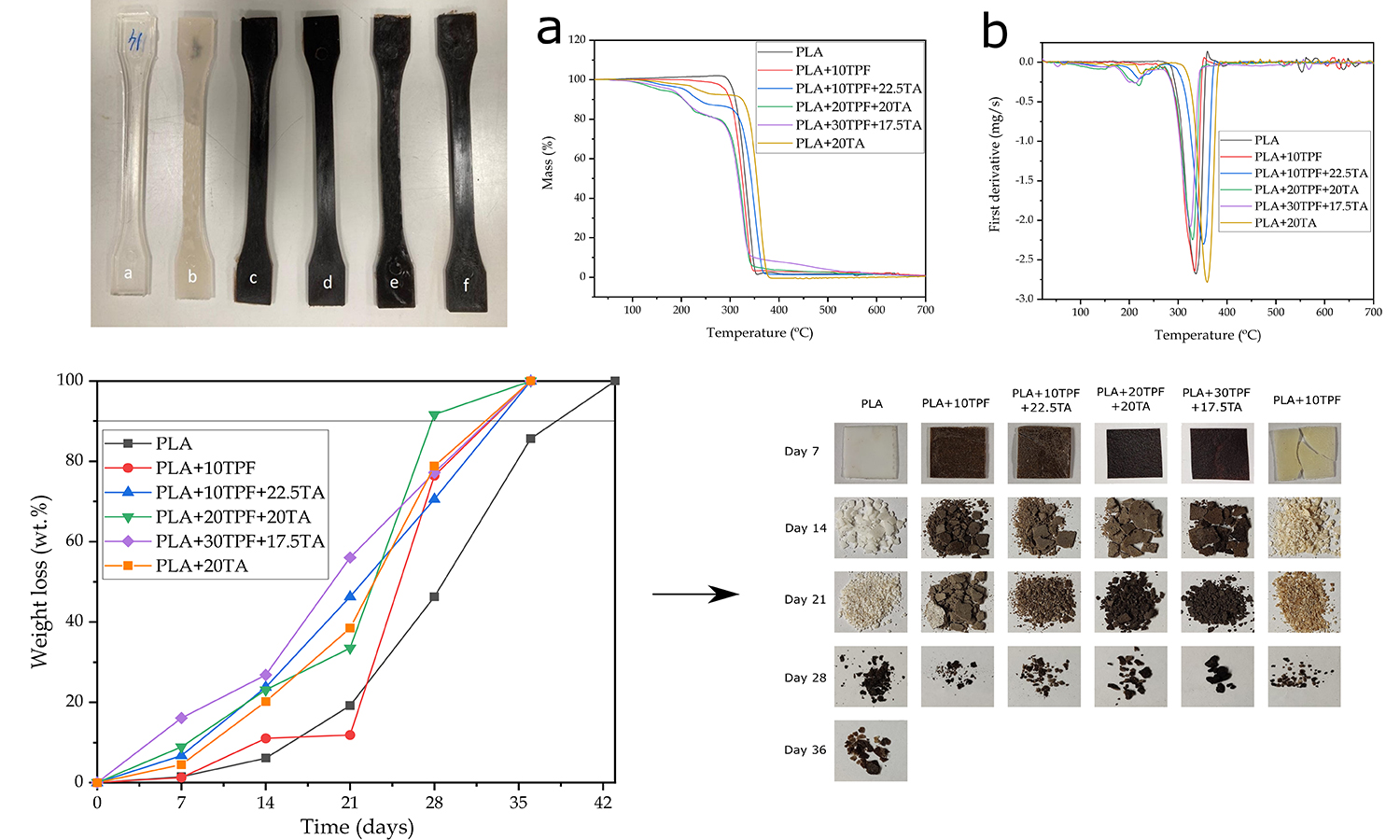
The present work reports on the development of environmentally friendly, completely biodegradable wood plastic composites based on polylactide (PLA) and tangerine peel flour (TPF), plasticized by α-terpinyl acetate (TA). The TPF varied in the 10–30 wt% while the PLA to TA (wt%/wt%) was set to 4 (i.e., 25 wt% TA plasticizer was added with regard to the PLA wt%). The developed composites were processed by extrusion and injection molding. The composites presented excellent elongation at break, achieving values of 300% for the PLA+TA sample. Elongation at break values of 200% for the PLA composite with 10 wt% TPF and plasticized with TA were obtained. Those results were confirmed by the appearance of filament-like structures observed in field emission scanning electron microscopy images. Differential scanning calorimetry and dynamic mechanical thermal analysis revealed a remarkable decrease in the glass transition temperature of PLA as a result of the plasticizing effect of TA. Glass transition was reduced from 63°C down to 41°C approximately. This implied an increase in the ductility of the material. The samples with TPF exhibited a dark brown color, making them perfect for wood plastic composite applications. Water contact angle results show that TA and TPF change the wetting properties of the obtained composites. A general decrease in the water contact angle was observed with the addition of TPF and TA. Finally, disintegration tests proved that the developed composites are fully biodegradable. All the samples except for neat PLA achieved 100% disintegration in controlled compost soil conditions after 5 weeks, while neat PLA reached complete disintegration in 6 weeks.
Shehroze Tahir Khan, Murtuza Mehdi, Tariq Jamil
Vol. 17., No.8., Pages 806-818, 2023
DOI: 10.3144/expresspolymlett.2023.60
Vol. 17., No.8., Pages 806-818, 2023
DOI: 10.3144/expresspolymlett.2023.60
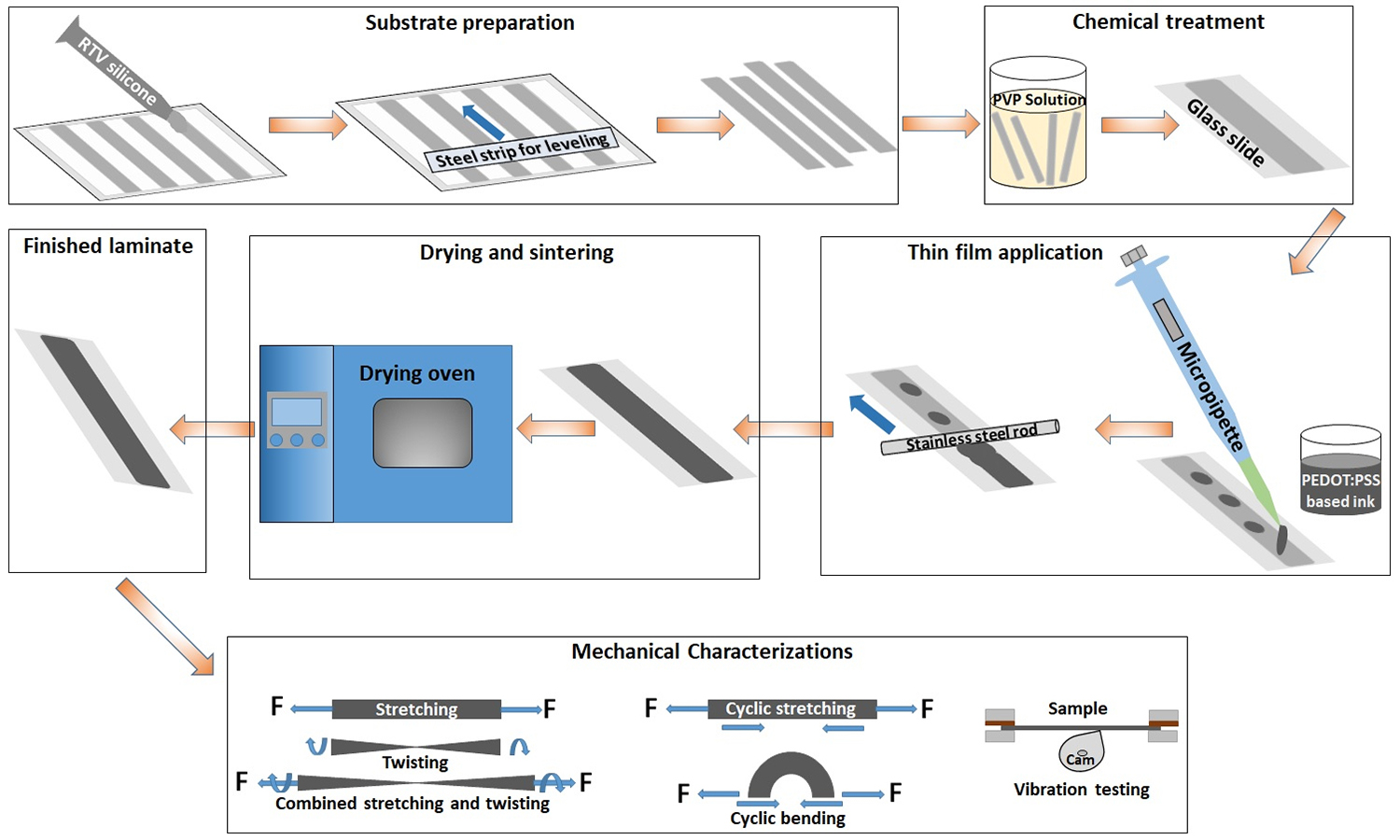
Conductive polymer poly(3,4-ethylenedioxythiophene):poly(styrenesulfonate) PEDOT:PSS is the most widely used material in stretchable and flexible electronics not only due to its good electrical and mechanical properties but also its use in numerous biomedical sensing applications. This article investigates the electromechanical behavior of PEDOT:PSS and its nanocomposite thin film. The films were rod-coated on a chemically treated, cost-effective single-component polymer that was previously characterized as an alternative available substrate material for stretchable and flexible microelectromechanical systems (MEMS) based devices. The results show that the films exhibit stable resistive behavior in response to various applied mechanical loads such as stretching, twisting, combined stretching, and twisting and forced vibrations. The films also show good thermal stability at relatively high temperatures. The prepared films also reveal their applicability as thermal actuators. It was also found that adding nanophases of silver material in PEDOT:PSS enhances the performance of thin films. These results also suggest that the rod-coated PEDOT:PSS and its composite thin films may have versatile applications like stretchable, twistable, and vibration-tolerant conductors, thermal actuators, and devices for future low-cost MEMS devices.
Thananya Siriwas, Skulrat Pichaiyut, Markus Susoff, Svea Petersen, Charoen Nakason
Vol. 17., No.8., Pages 819-836, 2023
DOI: 10.3144/expresspolymlett.2023.61
Vol. 17., No.8., Pages 819-836, 2023
DOI: 10.3144/expresspolymlett.2023.61
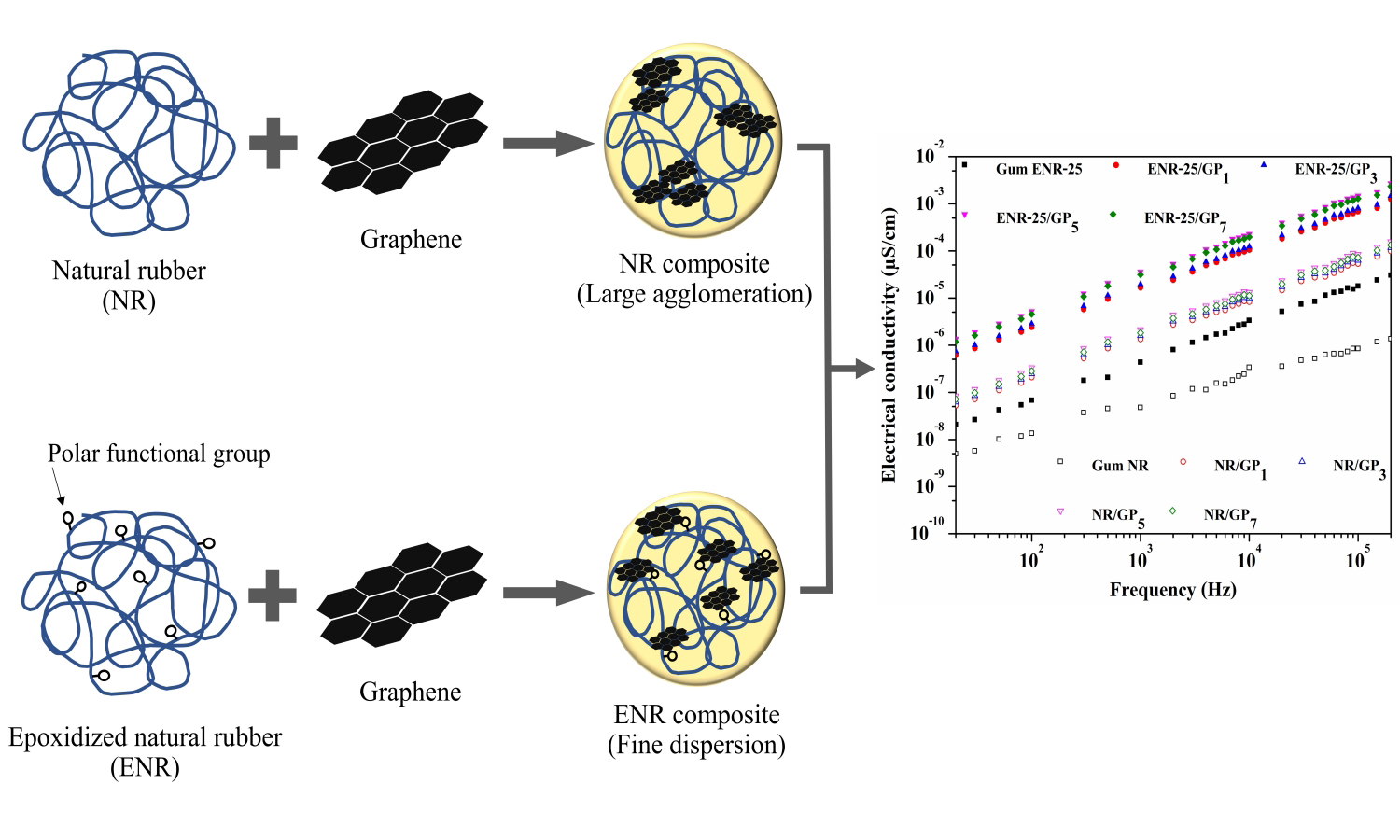
The properties of graphene (GP) filled rubber nanocomposites were investigated in functions of rubber type (unmodified natural rubber (NR) and epoxidized natural rubber with 25 mol% epoxides (ENR-25)) and filler content. The Fourier transform infrared spectroscopy (FTIR) spectrum indicated that GP surfaces contain polar hydroxyl and carbonyl functional groups. The ENR-25/GP compound exhibited higher maximum torque, torque difference, storage modulus, initial relaxation modulus, bound rubber, and degree of reinforcement with smaller GP aggregates dispersed in the rubber matrix than the NR/GP composites. Additionally, an increasing trend of tensile strength was observed in the ENR-25/GP composite, but the contrary trend was obviously seen in the NR/GP composites due to the interaction between polar functional groups in ENR-25 and GP surfaces. Furthermore, a higher Payne effect (filler-filler interaction) was found in the NR/GP composites, corresponding to larger GP agglomerates and voids dispersed in the NR matrix. Moreover, the ENR-25/GP composite had higher electrical conductivity and dielectric constant than the NR/GP composite due to the higher polarity of the ENR with the dipoles, leading to increasing orientation polarization and interfacial polarization.
Milán Ferdinánd, Róbert Várdai, Thomas Lummerstorfer, Claudia Pretschuh, Markus Gahleitner, János Móczó, Béla Pukánszky
Vol. 17., No.8., Pages 837-849, 2023
DOI: 10.3144/expresspolymlett.2023.62
Vol. 17., No.8., Pages 837-849, 2023
DOI: 10.3144/expresspolymlett.2023.62
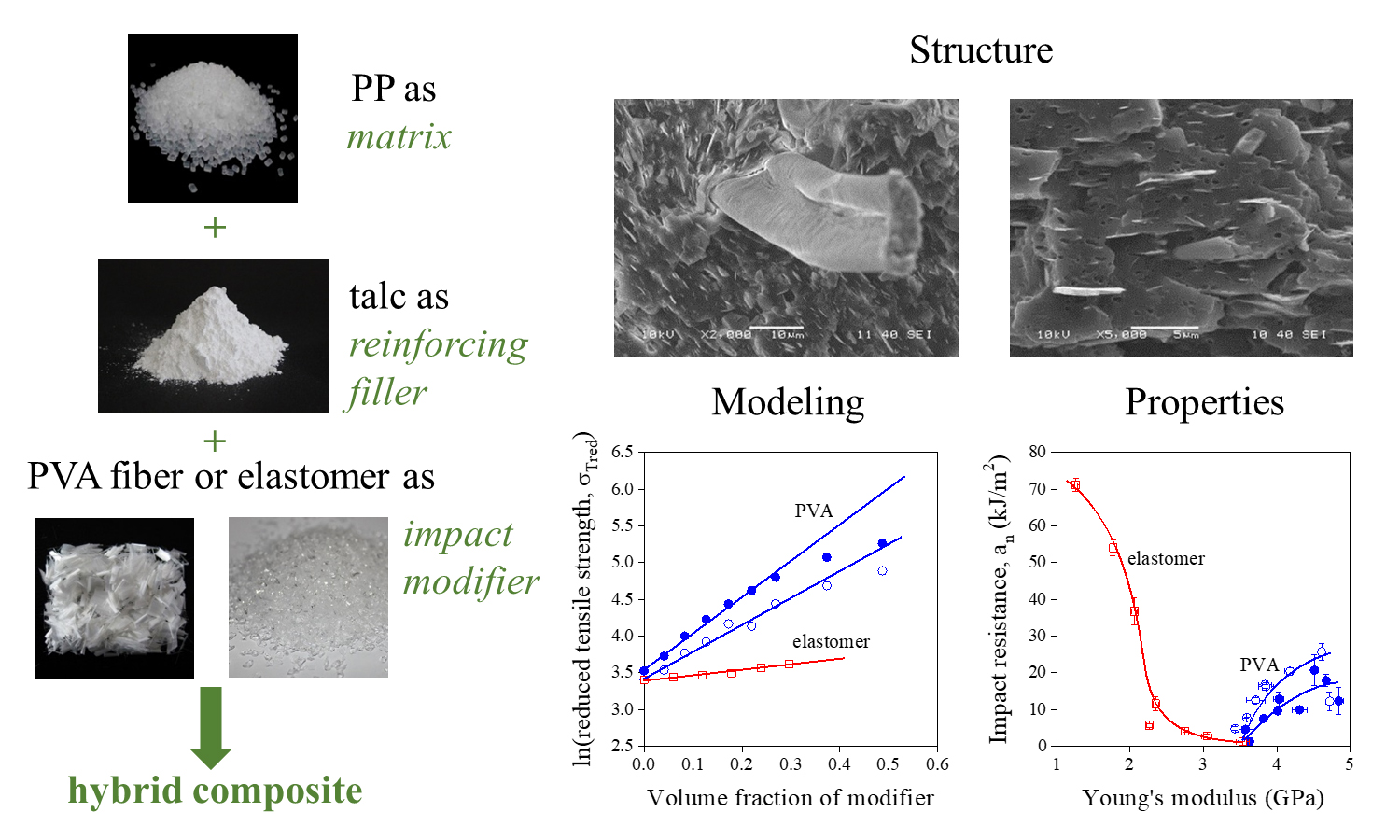
Polypropylene (PP) hybrid composites were prepared with talc, a reinforcing filler, and an additional impact modifier. Impact resistance was improved by the use of a traditional elastomer and by the new approach of adding a synthetic polymer fiber, poly(vinyl alcohol) (PVA), in this case. The results showed that the use of PVA is more efficient than that of the elastomer. The latter decreases stiffness considerably, from the 3.5 GPa value of the PP/talc composite to around 1.5 GPa, it does not carry practically any load, and even its impact modification efficiency is somewhat smaller than that of the PVA fibers. On the other hand, PVA increases stiffness to some extent, up to 5 GPa, tensile strength considerably, especially in the presence of a coupling agent, and the large impact resistance of 20 kJ/m2 can be achieved with it at moderate fiber contents. The positive property profile achieved is the result of the local deformation mechanisms occurring in the PP/talc/PVA composites. Properties can be further adjusted to purpose by the application of a functionalized PP coupling agent.
Apinya Krainoi, Kanoktip Boonkerd
Vol. 17., No.8., Pages 850-866, 2023
DOI: 10.3144/expresspolymlett.2023.63
Vol. 17., No.8., Pages 850-866, 2023
DOI: 10.3144/expresspolymlett.2023.63
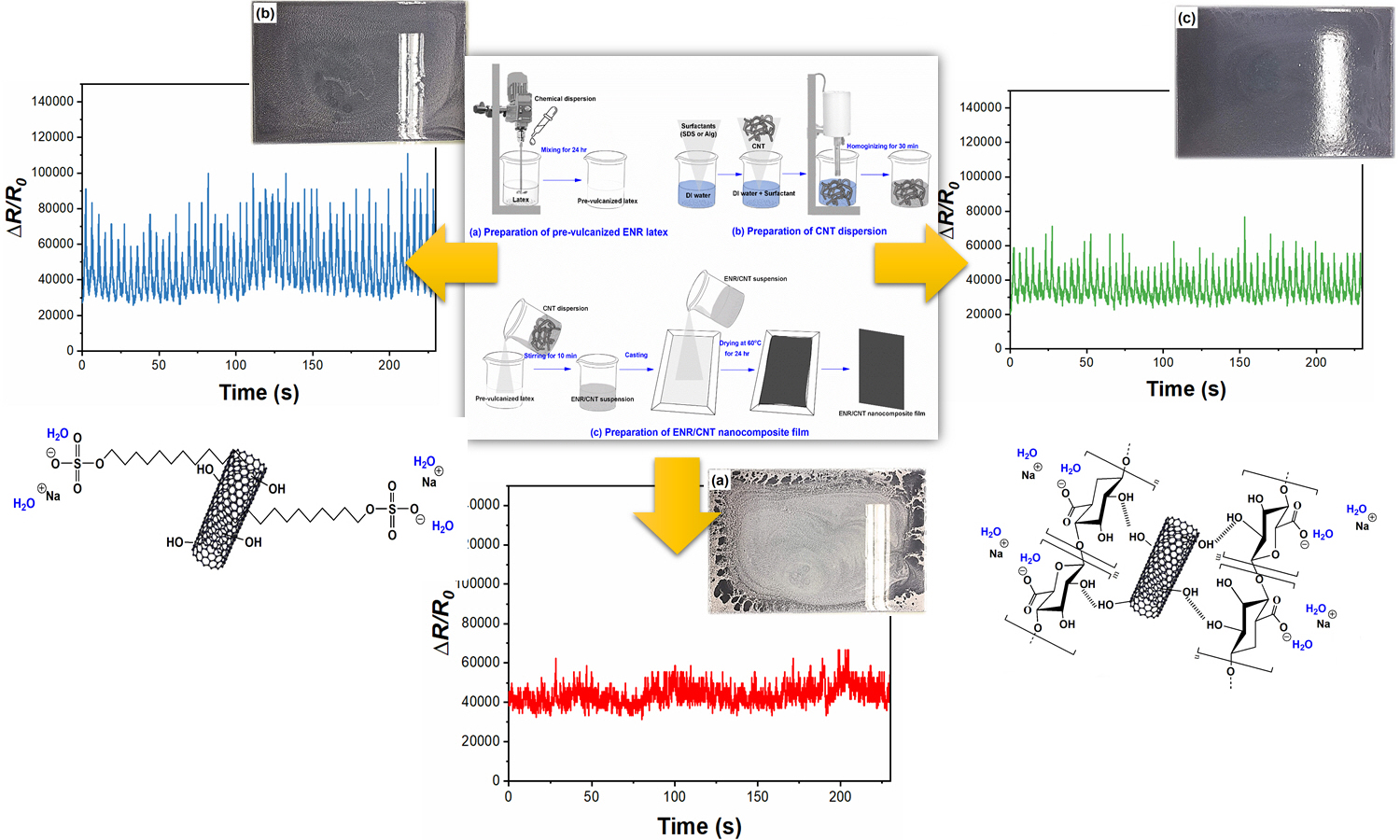
This study focused on the role of sodium alginate (Alg) as a surfactant in the mechanical/electrical properties and strain sensibility of carbon nanotube (CNT)-filled epoxidized natural rubber (ENR) nanocomposite. The preparation of ENR nanocomposite was carried out by a latex mixing process. CNTs were pre-treated with a dispersing agent and added to the ENR latex. To enhance the mechanical and electrical properties of nanocomposites for application as a strain sensor, we performed the homogenization of ENR/CNT suspension and fine dispersion of CNT in the ENR matrix. The effect of Alg on the properties of nanocomposites was estimated and compared with that of a common latex surfactant, that is, sodium dodecyl sulphate. The mechanical, electrical properties and strain sensitivity of ENR nanocomposites were improved with the use of Alg. In addition, the ENR nanocomposite films from latex technology mixing can be used in strain sensor applications, such as those with finger motion sensitivity.
Yu-Zhe Huang, Selvaraj Nagarajan, Widyantari Rahmayanti, Li-Ting Lee, Eamor M. Woo
Vol. 17., No.8., Pages 867-880, 2023
DOI: 10.3144/expresspolymlett.2023.64
Vol. 17., No.8., Pages 867-880, 2023
DOI: 10.3144/expresspolymlett.2023.64
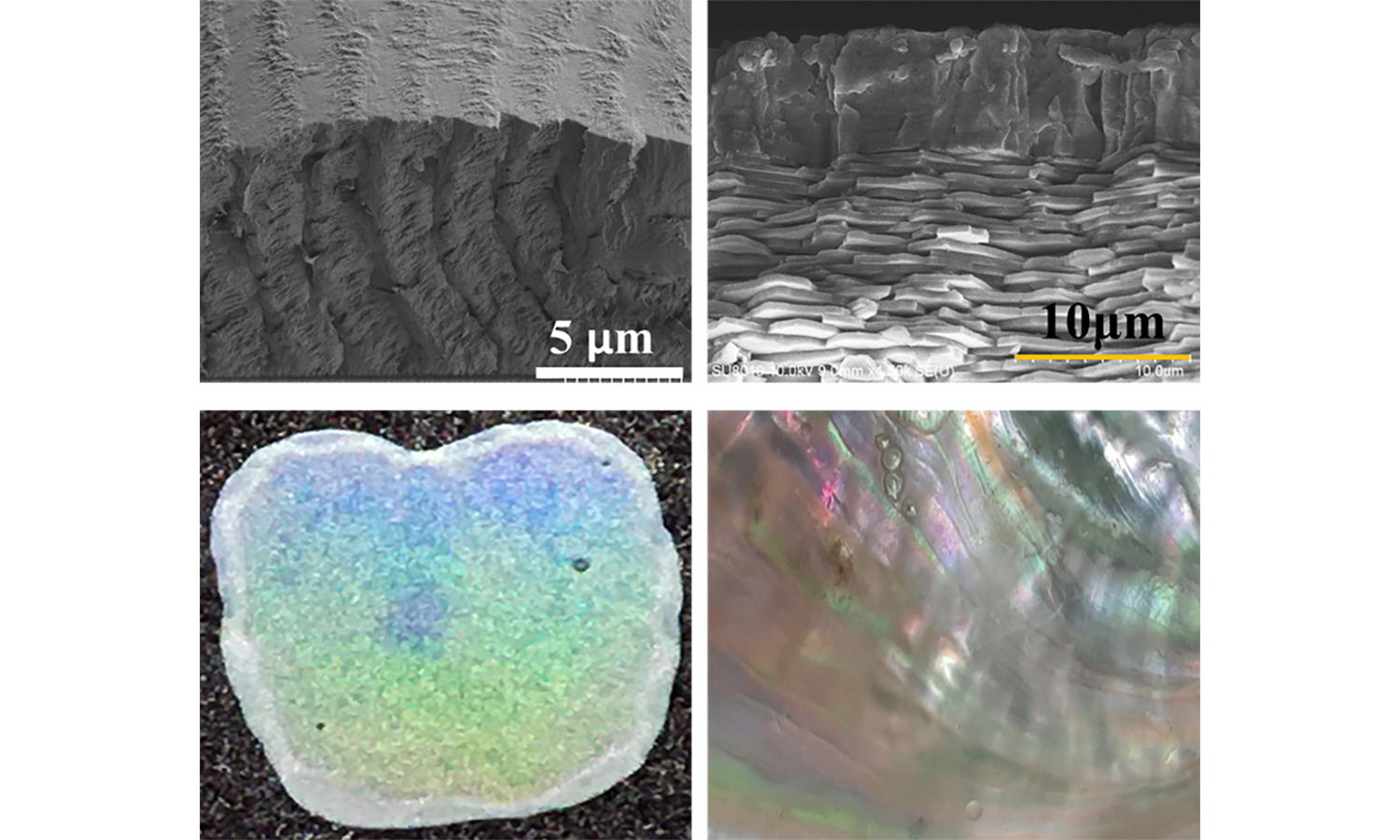
Poly(octamethylene terephthalate) (POT), self-assembled with periodically banded aggregates, are analyzed using polarized-light optical microscopy and scanning electron microscopy. POT can display banded spherulites (with blue/orange tint colors), depending on crystallization temperature. 3D interior morphology dissection is conducted to reveal the gratinglike architecture of POT periodically banded crystal aggregates. The grating assembly is composed of onion-like layers (i.e., corrugate-board cross-hatches), with distinctly discontinuous interfaces existing between the successive layers, and each layer is composed of tangential-oriented fibrous lamellae and plate-like radial-oriented ones. Novel findings confirm that the interior gratings of ring-banded POT are comparable to the grating micro-structures commonly seen in nature’s biospecies such as butterfly’s wings. The POT microstructures could be finely modulated and tailored-made to functional applications as interfacial coating materials for performing photonics iridescence.


